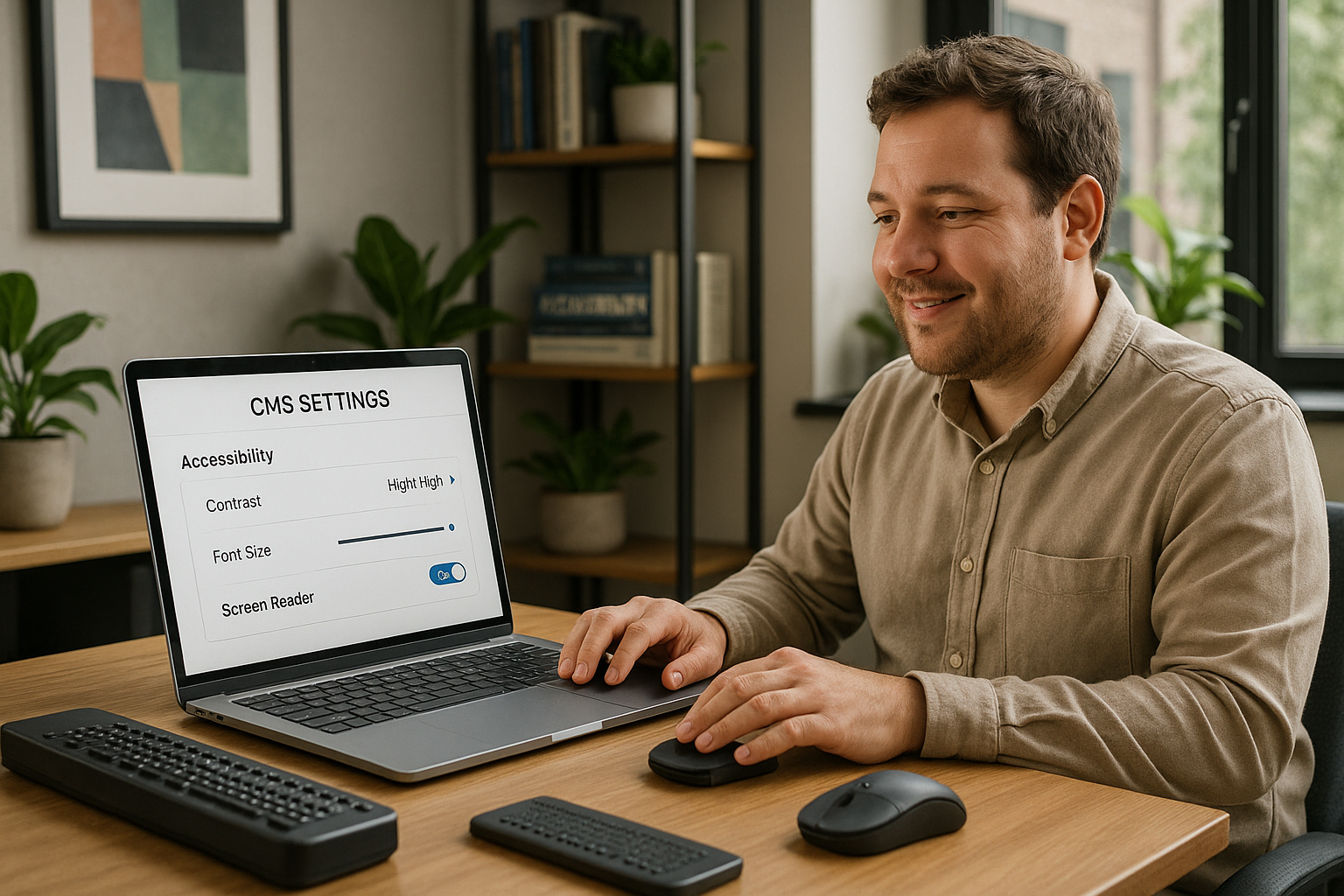A world where anyone, regardless of their physical abilities or technical prowess, can navigate and interact seamlessly with your website. This is not just a hopeful dream, but a reality that we can achieve through optimizing your CMS settings for inclusive user experiences. 🔓
While we may often think of accessibility as ramps or handrails in a physical environment, the digital world requires its own unique set of tools and strategies. This is where our journey begins, right at the intersection of technology and inclusivity, where we unlock accessibility in our CMS settings.
Before we delve into the heart of this matter, it’s crucial to understand what we mean by accessibility. In the digital realm, accessibility essentially means that people with varying abilities – whether visual, auditory, motor, or cognitive – can perceive, understand, navigate, and interact effectively with your website. It’s about breaking down barriers, shattering glass ceilings, and empowering every user. 💪
How do we ensure this? By unlocking accessibility through optimizing our CMS settings. It’s akin to having a master key that opens all doors, leaving no room, no user, no experience inaccessible. But the question here is – how do we create this key? What are the settings we need to adjust, the code we need to tweak, the pathways we need to pave? This, dear reader, is the mission we’re embarking on together.
In this comprehensive guide, we’re going to delve into the nuances of making your website more accessible. 🎯 We’ll discuss how to tailor your CMS settings, explore tools and techniques that are pivotal in the optimization process, and present concrete strategies that can turn the most complex labyrinth into a walk in the park for your users.
We’ll start by examining the importance of clear and structured content. This goes beyond just text – think images, videos, audio, and more. You’ll see how small changes can make a world of difference for users with visual or auditory impairments. We’ll then turn our attention to the technical side of things, diving into the nitty-gritty of HTML and CSS, and how you can use these languages to enhance the accessibility of your site.
Next, we’ll introduce you to the world of assistive technologies. From screen readers to Braille displays, these tools are often the first line of defense in overcoming barriers on the web. We’ll explore how they work, and more importantly, how you can make your website compatible with them.
But that’s not all! We’ll also touch upon the role of design in accessibility, emphasizing the power of simple and intuitive interfaces. By the end of this guide, you’ll have a comprehensive understanding of how to make your website not just accessible, but truly inclusive. 🌐
So buckle up and get ready for a deep dive into the world of web accessibility. Your journey to creating an inclusive user experience starts here. Let’s unlock accessibility together!
Unlocking Accessibility: The Key to Inclusive User Experiences
When it comes to creating a stellar user experience, accessibility is paramount. An inclusive digital environment ensures that all users, regardless of their abilities or disabilities, can engage effectively with your content. Today, we’ll delve into how optimizing your Content Management System (CMS) settings can lead to an inclusive user experience.
As we embark on this journey, we’ll cover the essential components of web accessibility, including navigation and content structure, multimedia accessibility, and the importance of accessible forms. Along the way, we’ll look at the steps necessary to fine-tune your CMS settings to foster an inclusive user experience.
One caveat to bear in mind is that the field of web accessibility is extensive. There’s always more to learn and better ways to improve your site’s accessibility. Therefore, the guidelines and recommendations we’ll discuss should be viewed as a starting point, not the ultimate destination. To help you on your path, I suggest watching ‘Web Accessibility Guidelines – Introduction’ by Google Chrome Developers on YouTube.
Understanding Web Accessibility
Web accessibility is an umbrella term that encompasses all the practices, tools, and technologies designed to make the web more inclusive. It’s about removing barriers that prevent interaction with, or access to, websites by people with disabilities.
The core of web accessibility lies in the principles outlined by the Web Content Accessibility Guidelines (WCAG), which form the foundation for most web accessibility laws worldwide. According to WCAG, a website should be perceivable, operable, understandable, and robust. This means that all users should be able to perceive content, navigate and interact with the website, understand the content and interface, and access the content consistently.
To meet these standards, there are various aspects to consider. Let’s dive deeper into these considerations, beginning with navigation and content structure.
Navigation and Content Structure
Users should be able to navigate through your site with ease, whether they’re using a mouse, keyboard, or assistive technology like a screen reader. This requires a logical and consistent structure for your content. Headings, links, and menus should all be easily identifiable and work as expected.
Furthermore, a well-structured page is not only beneficial to users but also to search engines. The logical organization of content helps search engines understand your page, improving your SEO ranking. Watch the YouTube video ‘Web Accessibility Tutorial – Navigation and Links’ by Wuhcag for a better understanding of this aspect.
When it comes to optimizing your CMS for better navigation and content structure, there are several steps to take. These include using the correct HTML elements for headings and lists, providing clear and concise link text, and ensuring that your navigation menus are accessible.
Creating Accessible Multimedia Content
In the digital age, multimedia content has become an integral part of the web. Images, videos, and audio files can enhance the user experience and deliver information in an engaging way. However, they can also create barriers for users with certain disabilities. Thus, it’s crucial to make your multimedia content accessible.
There are several ways to make multimedia content accessible. For images, use alt text to describe the image. For videos, provide captions or a transcript. For audio content, provide a transcript or a sign language interpretation. These methods ensure that your multimedia content is perceivable by all users.
Furthermore, when optimizing your CMS settings, consider including features that enable users to control multimedia content. For example, they should be able to pause, stop, or adjust the volume of audio or video content. Also, remember to avoid automatic playback of multimedia content, as it can be disruptive or disorienting for some users.
Accessibility of Forms
Forms are a common feature on websites, used for a variety of purposes – from signing up for newsletters to completing purchases. However, forms can often be a source of frustration for users if they’re not designed with accessibility in mind.
An accessible form should have clear and concise labels for all form fields. If there’s an error, the form should provide a clear error message and guide the user to the problematic field. Users should also be able to navigate through the form using the keyboard alone.
In optimizing your CMS settings for form accessibility, ensure that all form fields have a corresponding label element. Also, provide error identification and suggestion mechanisms, and make sure that the form works well with keyboard navigation.
Comparing CMSs for Accessibility
Now that we have discussed the key elements of web accessibility, let’s look at how different Content Management Systems fare in terms of accessibility. The table below provides a comparison of the accessibility features of three popular CMSs: WordPress, Drupal, and Joomla.
| Content Management System | Accessibility Features |
| WordPress | Offers a variety of plugins to improve accessibility, including WP Accessibility and Accessible Poetry. Themes like Twenty Twenty-One are also built with accessibility in mind. |
| Drupal | Has strong accessibility features built-in, including form and fieldset handling, color contrast and intensity checking, and alternative text for images. |
| Joomla | Comes with several built-in accessibility features, including a color contrast checker, font size changer, and keyboard navigation. Additionally, Joomla 4 has been designed with a focus on accessibility. |
As you can see, each CMS has its own strengths and weaknesses in terms of accessibility. When choosing a CMS, it’s crucial to consider not only its accessibility features but also its flexibility and ease of use.
Final Thoughts
Web accessibility is not an afterthought but a necessity in today’s digital world. By optimizing your CMS settings for accessibility, you can create a more inclusive user experience and reach a wider audience. Remember, an accessible website benefits all users, not just those with disabilities.
As we’ve discussed, web accessibility involves various aspects, from navigation and content structure to multimedia content and form accessibility. While this might seem daunting at first, the payoff is well worth the effort. Not only does it help you meet legal requirements and ethical standards, but it also improves your SEO and enhances user satisfaction.
So, why not start optimizing your CMS settings for accessibility today? Check out the YouTube video ‘How to Make Your Website Accessible’ by Moz for some practical tips and strategies. After all, an accessible website is a better website for everyone. 💻🌐👍

Conclusion
In conclusion, we have traversed through a broad spectrum of intricacies involved in the world of Information Technology and Engineering, particularly with a focus on Software Engineering. The various facets of our discussion encompassed details of software design, development, testing, and maintenance. We also delved into the significance of specific engineering principles and their impact on the overall software development life cycle.
The takeaways from our discourse are manifold. Primarily, we saw how a well-structured and systematic approach to software engineering can revolutionize the way we design and develop software. We observed that a good understanding of the technical requirements and a thorough knowledge of the necessary tools and technologies can make a significant difference in the output.
Secondly, we discovered the role of software testing in ensuring the quality and reliability of the product. We found that regular and rigorous testing can help in identifying potential issues in the early stages of development and mitigate them before they escalate into major problems.
Lastly, we touched upon the importance of software maintenance in extending the lifespan and improving the performance of the software. Regular updates and bug fixes can help in keeping the software in tune with the changing requirements and technological advancements.
In this digital age, where software has become an integral part of our lives, the importance of software engineering cannot be overstated. It is the backbone of the IT industry and plays a crucial role in shaping the future of technology.
As we have explored these topics in great detail, I encourage you to further delve into them, apply your newly gained knowledge, and share your insights. You can find more information on these subjects in various online resources such as IEEE Computer Society Digital Library and Springer’s Computer Science hub.
Remember, technology is an ever-evolving field, and there’s always something new to learn. By expanding our knowledge and sharing our insights, we can contribute to the growth of this exciting industry. 🚀
Thank you for investing your time in reading this piece, and I look forward to your thoughts, feedback, and contributions in the comments section below. If you found this article helpful, please do not hesitate to share it with your peers.
Here’s to the journey of constant learning and growth. 🥂
Tags: #SoftwareEngineering #IT #Technology #Development #Testing #Maintenance



